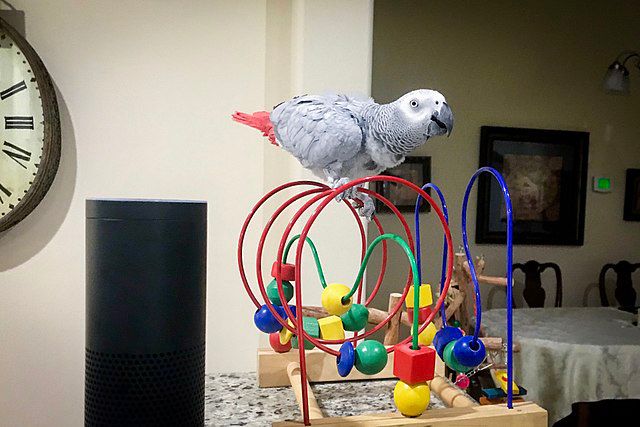Not all birds seem to play with toys. A possible reason for this is that the bird doesn’t know how to play. Although this may seem strange, it’s true. If this is the case with your bird, you need to teach it how to play.
You can do this by taking a variety of toys that he/she will have in the cage and showing your bird how much fun you have playing with the toy.
Inspect it, handle it, and generally play with it in close quarters of your parrot and act as though you’re having a brilliant time. This hopefully will intrigue the bird and spark its interest in the toy.
After a while, try handing it over to the parrot and let it inspect the toy. If he/she shows no interest, you may want to try again or have a go with another type of toy.
This may seem like a lot of work and a bit silly, but it is vital that a bird is capable of entertaining itself. It is unlikely that you will constantly be there to play with your parrot, so it must learn to play with its toys when you are not there to provide the entertainment. A bored bird can become stressed, a feather plucker, screamer, biter, or recluse.
It is also a good idea to rotate the toys in your parrot’s cage so that it does not become bored of playing with the same things. If you cannot afford lots of different toys, even just switching the positions of the toys to provide a ‘change of scenery’ can brighten your bird’s day!

Letting your parrot play its own way!
I once asked a parrot owner, “why don’t you give her some toys to play with?” I was told that the parrot “didn’t play with the toys, she just destroyed them.”
Well, that is exactly how parrots play with their toys! ‘Search and destroy’ is a favorite game of most parrots. It’s what comes naturally to them. My grey has a lot more fun destroying his ladder than he does climbing up and down it, and that’s fine by me if it keeps him happy and occupied.
At the moment, in my African Grey’s cage, there is a ladder, a swing, a large hanging rope-and-wooden-blocks-combo toy, a smaller rope and wood combo toy, a long cotton rope with knots running down it, 3 wooden perches, and a pedicure perch.
That may sound like a lot of toys to have in one parrot’s cage but the cage is quite large and the toys are arranged so that he has lots of perching, running, climbing, and stretching space.
I simply let him do as he wishes with the toys (mainly dismantling, chewing, and shredding into lots of tiny pieces), and when he has destroyed it, I replace it with a new toy for him to repeat the process! I do not, however, allow any of his toys to become dangerous. For example, if he were to partially destroy a toy that had any sharp or protruding edges, or cotton rope that could get him tangled, I would immediately remove that toy.
This may sound like an expensive process, but it really isn’t. You can buy thousands of different types of parrot toys that start at very reasonable prices. Plus, it’s unlikely that your parrot will be destroying one toy per day or even per week (although don’t hold me to that depending on your bird!)
Besides, it is your responsibility to care for your bird in the way it deserves. They are intelligent creatures that require a lot of stimulation to maintain happiness, good mental health, and a desirable personality. Nobody wants a depressed bird with behavioral problems!
